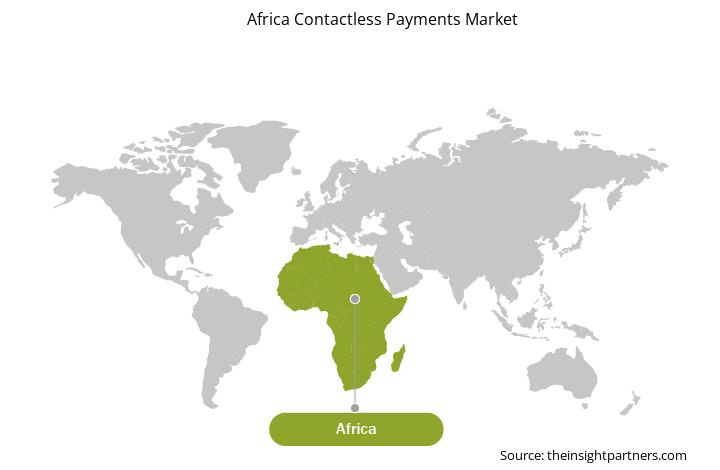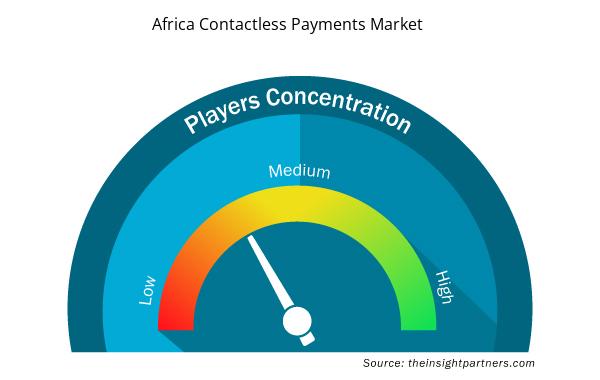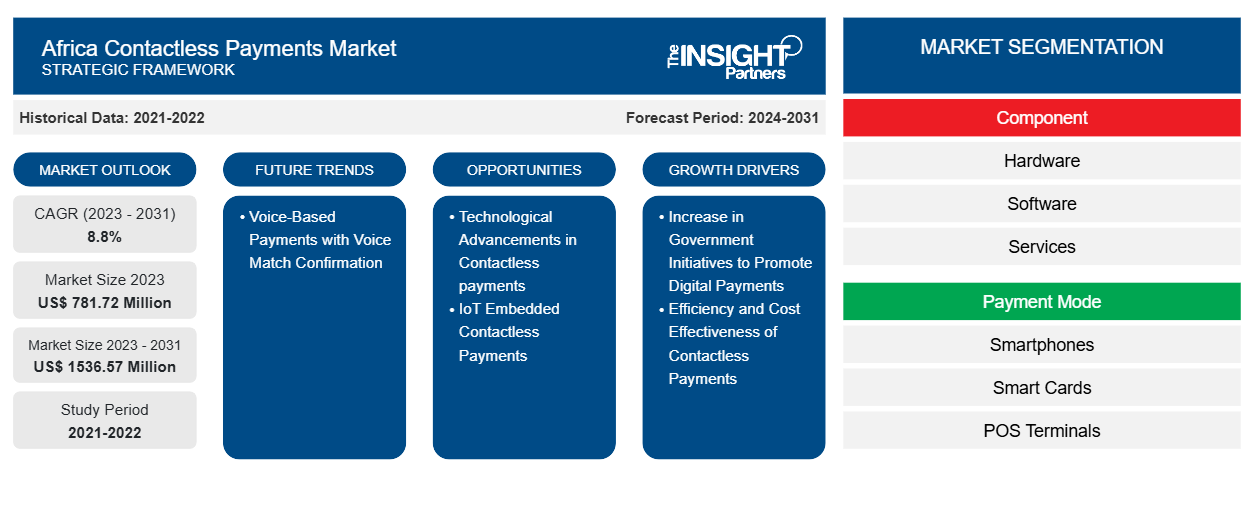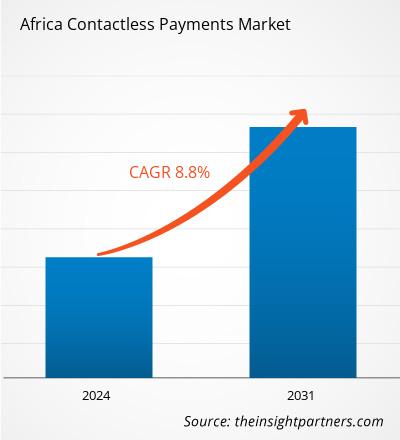2023 年非洲非接触式支付市场规模为 7.8172 亿美元,预计到 2031 年将达到 15.3657 亿美元,2023-2031 年复合年增长率为 8.8%。带有语音匹配确认的语音支付可能仍是市场的主要趋势。
非洲非接触式支付市场分析
非洲非接触式支付市场的发展受到以下因素的推动:数字支付平台和非接触式支付技术的日益普及、支付安全技术和解决方案的不断创新和进步;对更快、更安全、更便捷支付方式的需求激增;以及政府对开发智能支付基础设施和解决方案的举措和支持不断增加。物联网和人工智能与非接触式支付技术的融合以及新兴市场和地区的尚未开发的潜力预计将在未来几年为市场提供丰厚的机会。非接触式支付市场分散且竞争激烈,有多家地区和全球参与者广泛存在。
非洲非接触式支付市场概况
非接触式支付是一种安全便捷的支付方式,使用采用射频识别 (RFID) 技术和近场通信 (NFC) 的智能手机、借记卡或信用卡。这种支付方式通过在具有非接触式支付技术的销售点 (PoS) 终端上轻触或挥动支付设备来实现。该方法具有多种优势,例如减少交易时间和摩擦,因为客户无需在结账时输入 PIN 码或处理现金。此外,由于它安全且经过加密以防止欺诈性购买,因此它提高了客户体验和信任度。它为支付设备提供了灵活性,因为客户可以使用支持 NFC 的智能手机、可穿戴设备或非接触式卡进行支付。它还提供忠诚度福利,因为一些非接触式支付系统与忠诚度计划相结合,为客户提供折扣和奖励。
定制此报告以满足您的需求
您可以免费定制任何报告,包括本报告的部分内容、国家级分析、Excel 数据包,以及为初创企业和大学提供优惠和折扣
- 获取此报告的关键市场趋势。这个免费样品将包括数据分析,从市场趋势到估计和预测。
非洲非接触式支付市场驱动因素和机遇
政府加大力度推动数字支付
非洲各地的多个政府机构都在推广数字支付和金融技术。他们实施了鼓励采用非接触式支付的政策和举措。非洲见证了快速的技术进步,例如智能手机和移动互联网连接的广泛普及。这些因素促进了非接触式支付解决方案(尤其是移动钱包)的采用。该地区的支付提供商、金融机构和技术公司已经建立了战略伙伴关系和合作关系,以提高非接触式支付的采用和接受度。
2023 年 3 月,南非储备银行宣布推出一项更快捷的支付服务 PayShap。PayShap 是一个低价值的实时零售支付平台/计划,旨在通过使数字支付更加便捷,从而减少对现金的依赖,从而深化消费者和小型企业的金融包容性。推出的主要功能包括即时支付,即允许资金从一个银行账户转移到另一个银行账户,并使用代理(例如手机号码)将资金转移给收款人。请求支付功能正在开发中,将于 2024 年推出。PayShap 支持 2025 愿景的金融包容性、创新和竞争以及成本效益目标。因此,政府不断推出的促进数字支付的举措推动了非洲非接触式支付市场的增长。
非接触式支付的技术进步
将芯片卡或智能手机直接放在读卡器上的过程为非接触式支付提供了额外的安全性。NFC 由支持移动钱包的智能手机使用,例如 ApplePay。非接触式支付可以加快交易速度,提高客户满意度和忠诚度,并采用 NFC 等新支付技术,促进机器对机器通信和物联网集成。多张卡都配备了 NFC 技术,允许在接收卡读卡器附近轻触或挥动以进行非接触式支付。
移动设备在配备 NFC 的读卡器附近移动或轻触,类似于支持 NFC 的信用卡。此外,EMV(Europay、Mastercard 和 Visa 的缩写)芯片是使用信用卡进行 RFID/NFC 非接触式支付所必需的物理天线。虽然所有 EMV 芯片都支持 NFC 非接触式支付,但进行此类交易的能力取决于收款人。如果收取付款的 PoS 或票箱无法处理 NFC 付款,则通过将卡插入读卡器来使用该芯片。因此,非接触式支付的技术进步有望为非接触式支付市场提供有利可图的机会。
非洲非接触式支付市场报告细分分析
有助于得出非洲非接触式支付市场分析的关键部分是组成部分、支付模式和垂直行业。
- 根据组件,市场分为硬件、软件和服务。硬件部分在 2023 年占据了最大的市场份额。
- 就支付方式而言,市场分为智能手机、智能卡、PoS 终端和其他。智能手机领域在 2023 年占据了市场主导地位。
- 按行业垂直划分,市场分为零售、酒店、医疗保健、运输和物流、媒体和娱乐等。零售业在 2023 年占据了最大的市场份额。
非洲非接触式支付市场份额(按国家)分析
- 非洲非接触式支付市场分为南非、埃塞俄比亚、埃及、尼日利亚和非洲其他地区。非接触式支付正在整个非洲迅速普及,尤其是在撒哈拉以南非洲,那里有 144 家移动货币提供商正在推动消费者交易行为的变化。根据 Statista 的数据,M-Pesa(由 Safaricom 提供)、MoMo(由 MTN 提供)和 Orange Money 等领先企业占据着市场主导地位。电信公司处于这一转型的前沿,通过授权代理网络提供移动货币解决方案。这些服务使注册用户能够将资金存入虚拟钱包,从而促进各种金融交易,包括点对点 (P2P) 转账、付款和购买。
非洲非接触式支付市场区域洞察
Insight Partners 的分析师已详尽解释了预测期内影响非洲非接触式支付市场的区域趋势和因素。本节还讨论了非洲非接触式支付市场的各个部分和地理位置,包括北美、欧洲、亚太地区、中东和非洲以及南美洲和中美洲。

- 获取非洲非接触式支付市场的区域特定数据
非洲非接触式支付市场报告范围
| 报告属性 | 细节 |
|---|---|
| 2023 年的市场规模 | 7.8172亿美元 |
| 2031 年市场规模 | 15.3657亿美元 |
| 全球复合年增长率(2023 - 2031) | 8.8% |
| 史料 | 2021-2022 |
| 预测期 | 2024-2031 |
| 涵盖的领域 | 按组件
|
| 覆盖地区和国家 | 非洲
|
| 市场领导者和主要公司简介 |
|
非洲非接触式支付市场参与者密度:了解其对业务动态的影响
非洲非接触式支付市场正在快速增长,这得益于终端用户需求的不断增长,而这些需求又源于消费者偏好的不断变化、技术进步以及对产品优势的认识不断提高等因素。随着需求的增加,企业正在扩大其产品范围,进行创新以满足消费者的需求,并利用新兴趋势,从而进一步推动市场增长。
市场参与者密度是指在特定市场或行业内运营的企业或公司的分布情况。它表明在给定市场空间中,相对于其规模或总市场价值,有多少竞争对手(市场参与者)存在。
在非洲非接触式支付市场运营的主要公司有:
- 签证
- 万事达
- IBA 集团
- 捷德有限公司
- 艾迪米
- 城市卡科技有限公司
免责声明:上面列出的公司没有按照任何特定顺序排列。

- 了解非洲非接触式支付市场的主要参与者概况
非洲非接触式支付市场新闻和最新发展
通过收集一手和二手资料研究后的定性和定量数据来评估非洲非接触式支付市场,其中包括重要的公司出版物、协会数据和数据库。以下列出了非洲非接触式支付市场的一些发展情况:
- IBA Group 宣布 TapXphone 是全球首批 10 个符合 PCI MPoC 解决方案要求的解决方案之一。这意味着 tapXphone 符合在商用现货 (COTS) 设备上处理移动支付的最新安全标准。PCI MPoC 解决方案是 MPoC 安全标准中的一项关键认证。它由 PCI 委员会创建,设定了合规标准和最佳实践,以确保 tapXphone 满足所有必要的要求,包括安全开发、适当的维护、严格的安全标准和持续的系统检查。
(来源:IBA Group,新闻稿,2024 年 9 月)
- 万事达卡和 Beep 卡的母公司 AF Payments, Inc. (AFPI) 宣布建立战略合作伙伴关系,首次在菲律宾地铁 3 号线 (MRT-3 Line) 和公交车上实现万事达卡的非接触式受理。为支持政府加速支付数字化的目标,并遵照菲律宾央行的数字支付转型路线图,“万事达卡-Beep EMV 交通非接触式受理合作伙伴关系”旨在扩大菲律宾的非接触式受理范围。这一举措预计将为消费者的通勤体验带来更大的便利,简化访问流程,让旅行者能够使用万事达卡刷卡进出。
(来源:万事达卡,新闻稿,2024 年 2 月)
非洲非接触式支付市场报告覆盖范围和交付成果
“非洲非接触式支付市场规模和预测(2021-2031 年)”对市场进行了详细分析,涵盖以下领域:
- 非洲非接触式支付市场规模以及区域和国家层面所有主要细分市场的预测
- 非洲非接触式支付市场趋势以及市场动态,如驱动因素、限制因素和关键机遇
- 详细的 PEST 和 SWOT 分析
- 非洲非接触式支付市场分析涵盖主要市场趋势、区域框架、主要参与者、法规和最新市场发展
- 行业格局和竞争分析,涵盖市场集中度、热图分析、知名参与者以及非洲非接触式支付市场的最新发展
- 详细的公司简介
- 历史分析(2 年)、基准年、预测(7 年)及复合年增长率
- PEST 和 SWOT 分析
- 市场规模价值/数量 - 全球、区域、国家
- 行业和竞争格局
- Excel 数据集



Report Coverage
Revenue forecast, Company Analysis, Industry landscape, Growth factors, and Trends

Segment Covered
This text is related
to segments covered.

Regional Scope
North America, Europe, Asia Pacific, Middle East & Africa, South & Central America

Country Scope
This text is related
to country scope.
常见问题
The Increase in government initiatives to promote digital payments and efficiency and cost effectiveness of contactless payments are the factors driving the Africa contactless payments market growth.
The Africa contactless payments market was estimated to be USD 781.72 million in 2023 and is expected to grow at a CAGR of 8.8%, during the forecast period 2024 - 2031.
The efficiency and cost effectiveness of contactless payments are the major future trends for the Africa contactless payments market.
The key players, holding majority shares, in Africa contactless payments market includes Mastercard, Ingenico, Idemia SA, VISA, and Giesecke+Devrient.
The hardware segment led the Africa contactless payments market with a significant share in 2023.
The Africa contactless payments market is expected to reach US$ 1,536.57 million by 2031.
Trends and growth analysis reports related to Technology, Media and Telecommunications : READ MORE..
The List of Companies - Africa Contactless Payments Market
- Visa
- Mastercard
- IBA Group
- Giesecke + Devrient GmbH
- IDEMIA
- CityCard Technology Ltd
- EcoCash
- Ingenico
- Nedbank Ltd
- Sudo Africa, Inc.
The Insight Partners performs research in 4 major stages: Data Collection & Secondary Research, Primary Research, Data Analysis and Data Triangulation & Final Review.
- Data Collection and Secondary Research:
As a market research and consulting firm operating from a decade, we have published and advised several client across the globe. First step for any study will start with an assessment of currently available data and insights from existing reports. Further, historical and current market information is collected from Investor Presentations, Annual Reports, SEC Filings, etc., and other information related to company’s performance and market positioning are gathered from Paid Databases (Factiva, Hoovers, and Reuters) and various other publications available in public domain.
Several associations trade associates, technical forums, institutes, societies and organization are accessed to gain technical as well as market related insights through their publications such as research papers, blogs and press releases related to the studies are referred to get cues about the market. Further, white papers, journals, magazines, and other news articles published in last 3 years are scrutinized and analyzed to understand the current market trends.
- Primary Research:
The primarily interview analysis comprise of data obtained from industry participants interview and answers to survey questions gathered by in-house primary team.
For primary research, interviews are conducted with industry experts/CEOs/Marketing Managers/VPs/Subject Matter Experts from both demand and supply side to get a 360-degree view of the market. The primary team conducts several interviews based on the complexity of the markets to understand the various market trends and dynamics which makes research more credible and precise.
A typical research interview fulfils the following functions:
- Provides first-hand information on the market size, market trends, growth trends, competitive landscape, and outlook
- Validates and strengthens in-house secondary research findings
- Develops the analysis team’s expertise and market understanding
Primary research involves email interactions and telephone interviews for each market, category, segment, and sub-segment across geographies. The participants who typically take part in such a process include, but are not limited to:
- Industry participants: VPs, business development managers, market intelligence managers and national sales managers
- Outside experts: Valuation experts, research analysts and key opinion leaders specializing in the electronics and semiconductor industry.
Below is the breakup of our primary respondents by company, designation, and region:

Once we receive the confirmation from primary research sources or primary respondents, we finalize the base year market estimation and forecast the data as per the macroeconomic and microeconomic factors assessed during data collection.
- Data Analysis:
Once data is validated through both secondary as well as primary respondents, we finalize the market estimations by hypothesis formulation and factor analysis at regional and country level.
- Macro-Economic Factor Analysis:
We analyse macroeconomic indicators such the gross domestic product (GDP), increase in the demand for goods and services across industries, technological advancement, regional economic growth, governmental policies, the influence of COVID-19, PEST analysis, and other aspects. This analysis aids in setting benchmarks for various nations/regions and approximating market splits. Additionally, the general trend of the aforementioned components aid in determining the market's development possibilities.
- Country Level Data:
Various factors that are especially aligned to the country are taken into account to determine the market size for a certain area and country, including the presence of vendors, such as headquarters and offices, the country's GDP, demand patterns, and industry growth. To comprehend the market dynamics for the nation, a number of growth variables, inhibitors, application areas, and current market trends are researched. The aforementioned elements aid in determining the country's overall market's growth potential.
- Company Profile:
The “Table of Contents” is formulated by listing and analyzing more than 25 - 30 companies operating in the market ecosystem across geographies. However, we profile only 10 companies as a standard practice in our syndicate reports. These 10 companies comprise leading, emerging, and regional players. Nonetheless, our analysis is not restricted to the 10 listed companies, we also analyze other companies present in the market to develop a holistic view and understand the prevailing trends. The “Company Profiles” section in the report covers key facts, business description, products & services, financial information, SWOT analysis, and key developments. The financial information presented is extracted from the annual reports and official documents of the publicly listed companies. Upon collecting the information for the sections of respective companies, we verify them via various primary sources and then compile the data in respective company profiles. The company level information helps us in deriving the base number as well as in forecasting the market size.
- Developing Base Number:
Aggregation of sales statistics (2020-2022) and macro-economic factor, and other secondary and primary research insights are utilized to arrive at base number and related market shares for 2022. The data gaps are identified in this step and relevant market data is analyzed, collected from paid primary interviews or databases. On finalizing the base year market size, forecasts are developed on the basis of macro-economic, industry and market growth factors and company level analysis.
- Data Triangulation and Final Review:
The market findings and base year market size calculations are validated from supply as well as demand side. Demand side validations are based on macro-economic factor analysis and benchmarks for respective regions and countries. In case of supply side validations, revenues of major companies are estimated (in case not available) based on industry benchmark, approximate number of employees, product portfolio, and primary interviews revenues are gathered. Further revenue from target product/service segment is assessed to avoid overshooting of market statistics. In case of heavy deviations between supply and demand side values, all thes steps are repeated to achieve synchronization.
We follow an iterative model, wherein we share our research findings with Subject Matter Experts (SME’s) and Key Opinion Leaders (KOLs) until consensus view of the market is not formulated – this model negates any drastic deviation in the opinions of experts. Only validated and universally acceptable research findings are quoted in our reports.
We have important check points that we use to validate our research findings – which we call – data triangulation, where we validate the information, we generate from secondary sources with primary interviews and then we re-validate with our internal data bases and Subject matter experts. This comprehensive model enables us to deliver high quality, reliable data in shortest possible time.


 获取此报告的免费样本
获取此报告的免费样本